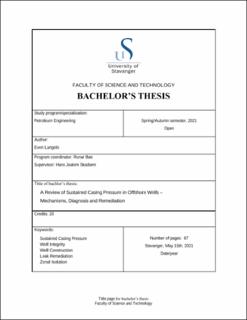| dc.contributor.advisor | Skadsem, Hans Joakim | |
| dc.contributor.author | Langelo, Even | |
| dc.date.accessioned | 2021-09-07T16:31:30Z | |
| dc.date.available | 2021-09-07T16:31:30Z | |
| dc.date.issued | 2021 | |
| dc.identifier | no.uis:inspera:78834598:22993348 | |
| dc.identifier.uri | https://hdl.handle.net/11250/2774460 | |
| dc.description.abstract | Sustained casing pressure (SCP) has in the later years received increased attention. SCP is the result of gas migration through failed or degraded well barriers manifesting at the wellhead as annular pressures that cannot be effectively bled off. Production and abandonment of such wells is associated with increased risks, but no consistently effective remediation technique exist today. For this thesis, a thorough literature review was conducted on mechanisms leading to leaks, both during well construction and later in the life of a well to provide a better understanding of the problem. The scope of the problem on the Norwegian Continental Shelf (NCS) and regulatory requirements pertaining to the affected wells is discussed. Remediation techniques and why these are often unsuccessful is presented and developments in technology for effective diagnosis and mitigation is discussed.
It is found that the problem can be caused by a variety of factors, and that effective zonal isolation is often compromised by microannulus formation between casing and cement sheath. Recent research has provided some promising solutions for treating the problem and useful insights to be used in the construction of new wells. Understanding the extent of mechanisms leading to SCP is important for solving and preventing the problem. | |
| dc.description.abstract | Sustained casing pressure (SCP) has in the later years received increased attention. SCP is the result of gas migration through failed or degraded well barriers manifesting at the wellhead as annular pressures that cannot be effectively bled off. Production and abandonment of such wells is associated with increased risks, but no consistently effective remediation technique exist today. For this thesis, a thorough literature review was conducted on mechanisms leading to leaks, both during well construction and later in the life of a well to provide a better understanding of the problem. The scope of the problem on the Norwegian Continental Shelf (NCS) and regulatory requirements pertaining to the affected wells is discussed. Remediation techniques and why these are often unsuccessful is presented and developments in technology for effective diagnosis and mitigation is discussed.
It is found that the problem can be caused by a variety of factors, and that effective zonal isolation is often compromised by microannulus formation between casing and cement sheath. Recent research has provided some promising solutions for treating the problem and useful insights to be used in the construction of new wells. Understanding the extent of mechanisms leading to SCP is important for solving and preventing the problem. | |
| dc.language | eng | |
| dc.publisher | uis | |
| dc.title | A Review of Sustained Casing Pressure in Offshore Wells - Mechanisms, Diagnosis and Remediation | |
| dc.type | Bachelor thesis | |
